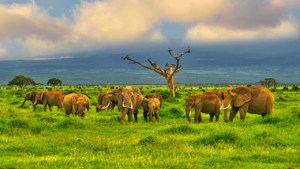Physical Address
23,24,25 & 26, 2nd Floor, Software Technology Park India, Opp: Garware Stadium,MIDC, Chikalthana, Aurangabad, Maharashtra – 431001 India
Physical Address
23,24,25 & 26, 2nd Floor, Software Technology Park India, Opp: Garware Stadium,MIDC, Chikalthana, Aurangabad, Maharashtra – 431001 India

Following a meticulous investigation spanning almost three years, a group of scientists have successfully unravelled the mystery behind a mass die-off of elephants in Zimbabwe. These puzzling events occurred between August and September 2020 when 35 elephant carcasses were discovered in various safaris and protected areas throughout the country. Eleven of these magnificent creatures died within a mere 24-hour period, raising considerable concern and prompting a thorough inquiry.
Initially, the team of experts entrusted with solving this puzzle ruled out deliberate poisoning, poaching, and the devastating impacts of drought conditions. Their extensive investigation, as detailed in a study published in Nature Communications, revealed no signs of external injuries on the deceased elephants. The cause of their death remained elusive, necessitating further investigation.
Facing a dearth of initial leads, the scientists decided to delve deeper into the matter. They conducted in-depth examinations of the brain, liver, and spleen tissues of 15 of the deceased elephants. Surprisingly, their analysis confirmed the presence of a specific bacterium known as Bisgaard taxon 45 in six of the elephant specimens. This discovery ultimately led to the conclusion that most, if not all, of the elephants, had succumbed to septicemia, a severe condition of blood poisoning induced by the pervasive Bisgaard taxon 45 bacteria. Pasteurellaceae Bisgaard taxon 45 is an unnamed close relative of Pasteurella multocida. It is a type that has been found previously in swabs taken from tiger or lion bites.
Climate Change and the spread of Bisgaard taxon 45
The transmission of this bacteria to elephant populations remains a mystery. The precise method by which the bacterium infects these animals remains unclear, although the study authors have suggested that factors induced by climate change, such as rising temperatures, prolonged droughts, and increased population density, may play a role in making such transmission more common.
Dr Chris Foggin, a veterinarian at Victoria Falls Wildlife Trust and one of the study’s co-authors, stressed that while it may be premature to definitively attribute these incidents to climate change, it could become a contributing factor in the future if harsher droughts and alterations in rainfall patterns persist. He remarked, “I do think that if that is the case, then we are more likely to see this sort of mortality event occurring again..”
While the bacteria itself is not commonly associated with causing the death of African elephants, the scientists noted a potential emerging pattern. Cases of blood infections in elephant herds have been reported in various regions across Africa, adding to the enigma surrounding how this bacterium spreads within these magnificent creatures. Additionally, similar cases affecting elephant populations have been observed in Asia.
Seven Asiatic elephants died between January and February 2021 at the Karlapat Wildlife Sanctuary in Kalahandi, Odisha due to haemorrhagic septicemia caused by the same bacteria- Pastuerella multocida. The elephants had likely contracted the bacteria from cattle residing at Tentulipada village, a small hamlet of 12 households, inside the sanctuary.
Challenges Faced by Zimbabwe’s Elephants
African elephants, scientifically known as Loxodonta africana, face severe challenges from activities like poaching and losing their natural habitats. They were officially classified as endangered on the 2021 IUCN Red List2, and between 2007 and 2014, their numbers dwindled by 144,000, leaving approximately 350,000 elephants remaining, with an ongoing annual decline of 8%, the study says.
The study says that in the past dry seasons, typically spanning from April to October, the north-western regions of Zimbabwe have witnessed recurring episodes of elephant mortality. These events have been attributed to various factors, including drought and anthrax infections, casting a shadow over the lives of these magnificent creatures.
Moreover, the illegal use of cyanide, often sourced from the gold mining industry in Zimbabwe, has emerged as a disturbing trend in recent years, leading to the tragic loss of elephant lives.
During the scorching and arid months of September to October in 2019, at least 200 elephants succumbed to the drought. These challenging conditions took a toll on the local elephant population, painting a grim picture of their struggle for survival.
This saga of isolated elephant mortality incidents continued beyond January 2020, with one notable occurrence involving the untimely deaths of 35 elephants in north-western Zimbabwe between late August and November 2020. This event raised further concerns about the welfare of these creatures.
What added to the intrigue of this situation was a preceding mass mortality event in northern Botswana, where approximately 350 elephants died between May and June 2020. Curiously, the common culprits of elephant mortality, such as poaching and anthrax infections, were ruled out in Botswana, leaving researchers grappling with the mystery of the deaths. The cause was eventually attributed to an unspecified cyanobacterial toxin, deepening the enigma surrounding these occurrences.
References:
https://www.businessinsider.in/science/news/35-elephants-suddenly-dropped-dead-in-2020-their-case-has-finally-been-solved-/articleshow/105029203.cms
https://www.nature.com/articles/s41467-023-41987-z?utm_medium=affiliate&utm_source=commission_junction&utm_campaign=CONR_PF018_ECOM_GL_PHSS_ALWYS_DEEPLINK&utm_content=textlink&utm_term=PID100024933&CJEVENT=a05c319d7df711ee83be4d360a18ba73